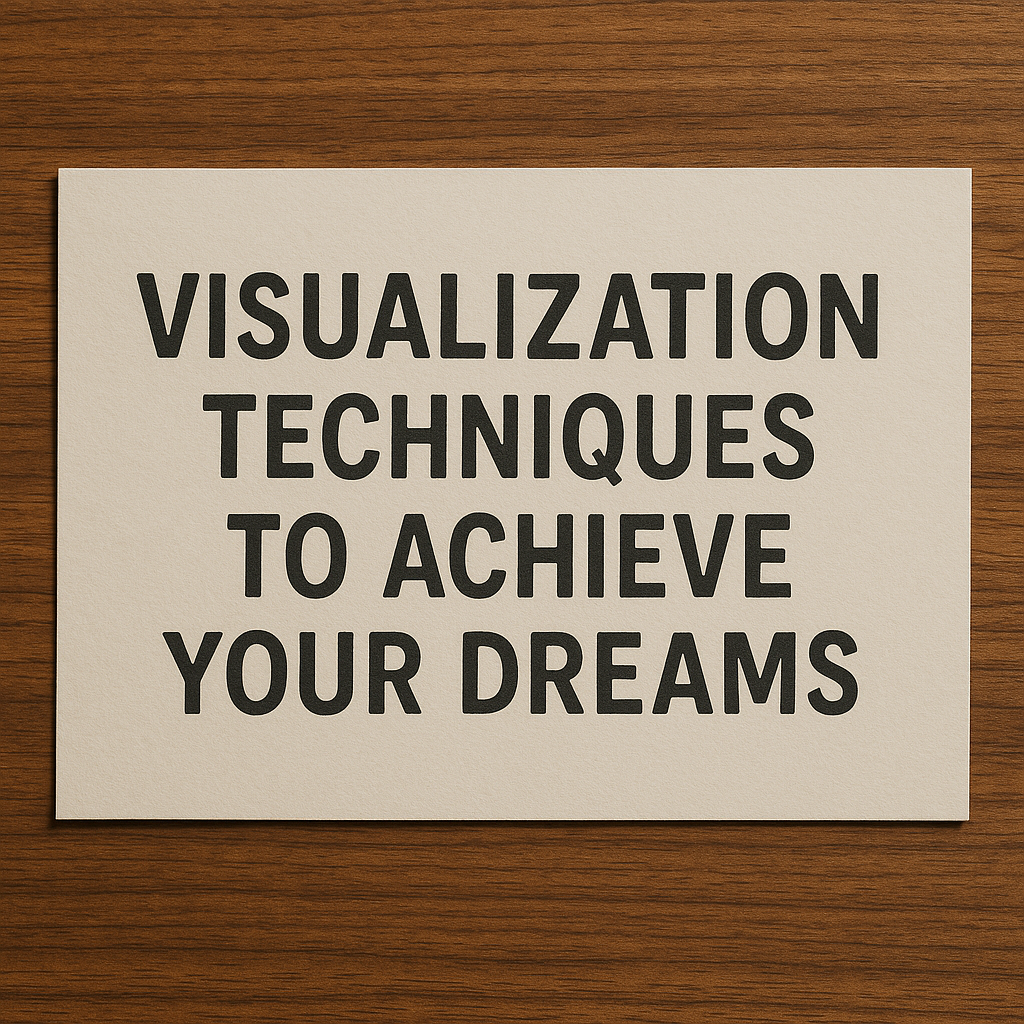What if you could mentally rehearse your success before it actually happens? That’s the magic of visualization—a technique used by athletes, entrepreneurs, and high achievers around the world to bring dreams to life. When done consistently and with intention, visualization helps align your mindset, emotions, and actions toward your goals.
What Is Visualization?
Visualization is the process of creating a clear and vivid mental image of something you want to achieve. It’s more than daydreaming—it’s an intentional and focused mental rehearsal of future success.
When you visualize, you’re training your brain to “experience” the outcome before it actually happens. This mental simulation influences your mindset, boosts motivation, and increases the likelihood of success.
How Visualization Works in the Brain
When you vividly imagine yourself performing a task, your brain activates the same regions as if you were actually doing it. Neuroscience shows that visualization strengthens the neural pathways associated with success, skill development, and emotional regulation.
For example:
- A basketball player imagining free throws improves shooting accuracy.
- A public speaker visualizing confidence reduces anxiety.
- A job seeker mentally rehearsing an interview performs better in real life.
Visualization connects your subconscious mind to your conscious goals—creating a powerful internal shift that enhances your belief and behavior.
The Benefits of Visualization
Practicing visualization regularly can bring profound changes in your life. Here are some of its top benefits:
1. Clarity of Purpose
Visualization helps clarify what you truly want. When you imagine the outcome in detail, your goals become more tangible and specific. That clarity is the first step toward taking meaningful action.
2. Increased Confidence
Seeing yourself succeed—even in your mind—builds belief. Visualization helps remove mental blocks, replacing them with confidence and certainty.
3. Reduced Stress and Anxiety
By mentally rehearsing challenges and visualizing a calm, successful response, you can reduce stress and increase emotional control in real-life situations.
4. Enhanced Motivation
Your brain begins to crave the reality you’ve imagined. That desire boosts your motivation and helps you stay committed to the journey.
5. Improved Performance
Whether you’re pursuing a physical, intellectual, or emotional goal, visualization sharpens your skills and prepares your mind for success.
How to Practice Visualization Effectively
Like any skill, visualization requires consistent practice and proper technique. Follow these steps to get the most from your sessions:
1. Find a Quiet, Comfortable Space
Sit or lie down somewhere quiet. Close your eyes and eliminate distractions. Take a few deep breaths to relax your body and focus your mind.
2. Set a Clear Intention
Choose one specific goal or scenario to focus on. Be as detailed as possible:
- What do you want to achieve?
- What does success look like?
- How will you feel when it happens?
3. Engage All Your Senses
Don’t just see the image—feel it, hear it, smell it. Make the visualization immersive:
- What are you wearing?
- Who is with you?
- What emotions are running through your body?
The more vivid the image, the more powerful the effect.
4. Visualize the Process, Not Just the Outcome
While it’s important to imagine success, visualizing the steps you take is just as critical. Mentally rehearse yourself:
- Staying focused
- Making smart choices
- Overcoming setbacks
- Showing resilience and confidence
This teaches your brain how to act in real situations.
5. Feel the Emotions of Success
Emotions are fuel. Feel the joy, gratitude, excitement, and pride as if your dream has already come true. Your brain responds strongly to emotions, anchoring the experience deeper into your subconscious.
6. Repeat Daily
Make visualization a daily habit, even for just 5-10 minutes. Morning and evening are great times because your mind is naturally more relaxed and receptive.
Bonus Techniques to Boost Visualization
In addition to the steps above, try these methods to make your practice even more effective:
✨ Vision Board
Create a visual collage of your goals using images, words, and symbols. Place it somewhere you’ll see every day. It keeps your goals in sight and in mind.
📝 Scripting
Write a journal entry as if your dream already came true. Describe your “future” day in full detail. This combines the power of visualization with affirmation and gratitude.
🎧 Guided Visualization
Use audio tracks that guide you through a mental journey. These can help you relax, focus, and create vivid mental imagery—perfect for beginners.
Common Mistakes to Avoid
Visualization is simple, but certain habits can reduce its effectiveness:
- Being vague or general – Always be specific.
- Focusing only on the dream, not the action – Visualize both the goal and the process.
- Only visualizing once – It’s consistency that rewires the brain.
- Forgetting to feel emotions – The emotional connection is what makes visualization powerful.
Real-Life Examples of Visualization in Action
Many successful people attribute part of their achievements to visualization:
- Oprah Winfrey often speaks about visualizing her success since childhood.
- Michael Phelps, the Olympic swimmer, used visualization before every race.
- Jim Carrey wrote himself a $10 million check before he was famous—and visualized earning it.
These are not isolated stories—they’re evidence of what’s possible when the mind and body work together.
Let Your Mind Lead the Way
Visualization is more than imagination—it’s rehearsal, programming, and alignment. When you visualize daily, you’re not just hoping for success. You’re preparing for it. You’re becoming someone capable of achieving what once felt impossible.
So, close your eyes, see your dream vividly, feel it in your heart—and then take the next step toward making it real.
